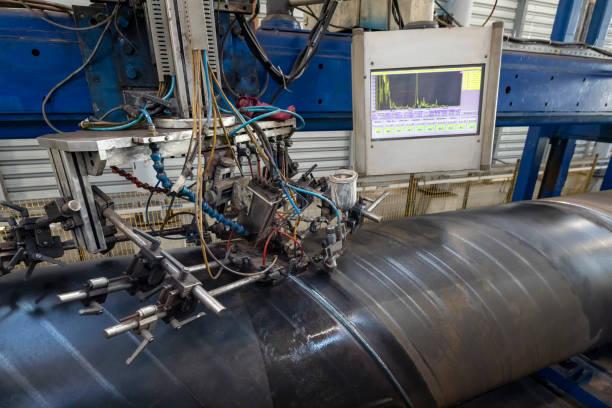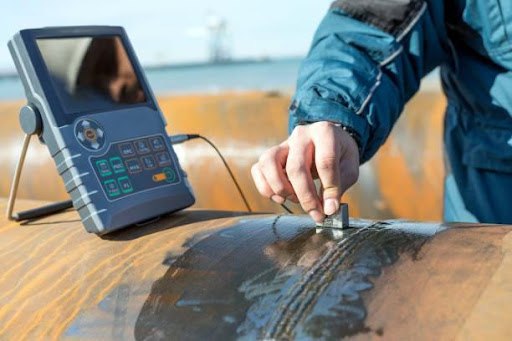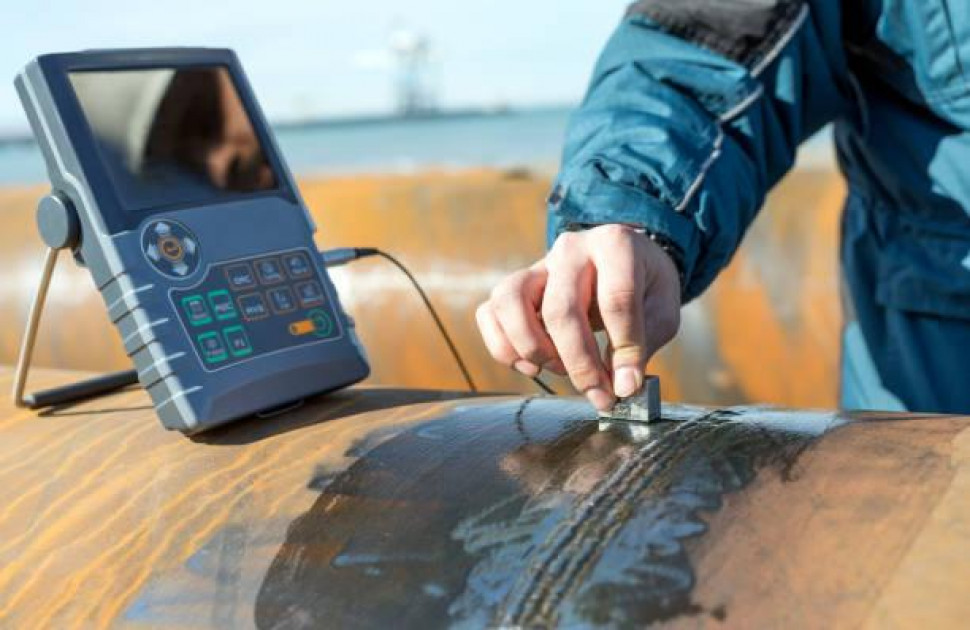Table Of Content
- Introduction
- What is Ultrasonic Testing of Welds?
- What is Ultrasonic Testing of Steel?
- Three Basic Ultrasonic Testing Methods
- Advantages Of Ultrasonic Testing
- Disadvantages of Ultrasonic Testing
- Key Takeaways
Introduction
Ultrasonic Testing, often referred to as UT, is a non-destructive testing method that leverages the utilization of ultrasonic waves to penetrate materials.
These ultrasonic waves, characterized by their high-frequency sound nature, are meticulously directed through diverse substances, employing ultrasonic testing (UT) as a fundamental technique for the identification of latent deformities within the examined object.
In the realm of ultrasonic testing (UT), the range of applicable frequencies can extend to 50 MHz; however, in practical applications, these frequencies are typically confined to the 0.1-15 MHz spectrum.
A significant attribute of ultrasonic waves is their effectiveness in assessing material thickness and ascertaining the presence of corrosion within pipelines.
Ultrasonic inspection and ultrasonic Non-destructive Testing (NDT) techniques have gained prominence in various global industries, underscoring their pivotal role in the evaluation of material integrity.
This encompasses meticulous ultrasonic examination to confirm the precision of welding processes and identify inherent flaws within the welded material.
Ultrasonic NDT testing, as a specific discipline within non-destructive testing (NDT), represents the heart of this methodology.
It relies on Ultrasonic Testing work conducted to ensure the quality and structural integrity of materials.
This method is adaptable, applying to both ferrous and non-ferrous materials, and it demonstrates efficiency in scenarios where materials are challenging to access.
Ultrasonic Testing (UT) stands as a cornerstone of non-destructive testing (NDT) techniques, effectively contributing to the assurance of material integrity and product quality.
What is Ultrasonic Testing of Welds?
This technique, often referred to as Ultrasonic Testing (UT) or ultrasonic non-destructive testing (NDT), utilizes mechanical vibrations, similar to sound waves but of much higher frequency.
This ultrasonic examination process starts with projecting a beam of ultrasonic energy directed into the material that has to be examined.
After this, the beam transits through the substance with an unimportant casualty, except when the beam is thwarted and reflected back by a deformity.
Then, ultrasonic Non-destructive Testing (NDT), a specific method within non-destructive testing (NDT) techniques, is utilized.
This specific system employs a transducer that transforms electrical energy into mechanical energy.
The Transducer is then energized by a high-frequency voltage, resulting in a crystal vibrating mechanically.
Here, the crystal probe becomes the sole source of ultrasonic mechanical vibration.
All these vibrations are transmitted into the test material via a coupling liquid, a film of oil, known as coupling.
Now, when the pulse of ultrasonic waves hits a defect in the tested object, it gets reflected back to its original point.
Hence, the energy returns to the transducers, which serve as both a source and a receiver for the reflected energy.
The first signal is the return of the echoes from the deformities, and the echo of the rear surface of the object is all showcased through a trace on the cathode ray oscilloscope screen.
The identification, position, and assessment of deformities are possible because the velocity of sound via a given substance is virtually constant.
This makes the measurement of distance possible, and the relative magnitude of a reflected pulse is proportional to the size of the reflector.
When it comes to ultrasonic testing inspection, the most beneficial trait is that it can specify the exact position of deformities in a weld.
However, this ultrasonic testing work requires greater skills, training, and competence.
Also, it relies on the application and establishment of favorable ultrasonic testing methods in Non-destructive Testing (NDT).
Plus, this method can also be utilized on ferrous and non-ferrous substances.
It is also suited for examining thicker parts approachable from one side and can identify finer lines that cannot be detected using radiographic NDT techniques.

What is Ultrasonic Testing of Steel?
Let us now delve into the subject of Ultrasonic Testing (UT) of steel.
This Non-destructive Testing Method primarily involves the use of exceedingly brief ultrasonic pulse waves, with frequencies typically spanning from 0.1 to 15 MHz, occasionally extending to 50 MHz.
For common metals, a frequency range of 1-4 MHz is conventionally applied.
These ultrasonic pulse waves are systematically directed into objects, serving as a foundational technique for the discernment of internal discontinuities within various metals.
Furthermore, it is imperative to acknowledge that ultrasonic testing (UT) plays a pivotal role in the classification of diverse material types.
The generation of sound energy within the material is the genesis of the process, and it propagates through the material in the form of waves.
In the presence of a disruption along the wave's path, the energy encounters an impediment and subsequently reflects from the flawed surface.
This phenomenon constitutes the bedrock of ultrasonic inspection and Non-destructive Testing (NDT).
It enables the comprehensive evaluation of the position, dimensions, orientation, and supplementary characteristics of the detected flaw.
Should you have any specific queries or seek further elucidation on the subject of ultrasonic testing (UT) and its manifold applications, please do not hesitate to inquire.
Three Basic Ultrasonic Testing Methods
- Pulse-Echo Technique:
Utilizes ultrasonic pulses to inspect materials and structures.
It measures the time delay of echoes to identify flaws or defects.
This method is commonly employed in non-destructive testing for welds and materials.
- Phased Array Ultrasonics:
This method employs an array of transducers to produce detailed images.
The apparatus electronically controls the angle and timing of ultrasonic beams.
This is ideal for creating comprehensive inspection images of complex structures.
- Time-of-Flight Diffraction (TOFD):
This technique focuses on diffraction patterns of ultrasonic waves.
It accurately locates and sizes defects within materials. TOFD is widely used for precise defect assessment, particularly in weld inspection.
Ultrasonic Testing Methods that also detect defects within welds include the following:
- Angle Beam Testing
- Ultrasonic Phased Array for Thickness Measurements
- Circumferential Scanning of Weld Pipes
- Immersion Testing
- Shear Wave Ultrasonic Testing
Advantages of Ultrasonic Testing
Ultrasonic testing has several benefits, a few of which are mentioned below:
- Zero or minimal preparation of the material to be tested.
- To detect the flaws, thickness measurement can be conducted.
- High sensitivity towards the surface as well as subsurface deformities.
- While utilizing the pulse-echo method, the object that has to be tested can only be accessed from one direction.
- When compared to other non-destructive testing techniques, ultrasonic testing possesses superior penetration depth.
- Using digital equipment gives quick outcomes.
- Provides higher preciseness & accuracy in specifying the place of the deformity and evaluating its shape & size.

Disadvantages Of Ultrasonic Testing
However, ultrasonic testing also has the below-mentioned limitations:
- Due to a lack of sensitivity towards linear flaws, inclined similarity to the sound beam propagation.
- There is a requirement for reference standards for equipment calibration and the classification of deformities.
- Ultrasonic Testing (UT) is more costly when compared to other methods.
- It is quite difficult to use thin substances.
- In this method, training is very extensive compared to others.
- Requires a relatively smooth surface to couple the transducer.
- Some complications can occur due to part geometry.
- The velocity of the part must be known, and a reference should be present to calibrate against equipment establishment.
The above-mentioned information is a simplified version & introduction to the non-destructive testing method of ultrasonic testing of weld and steel.
However, to effectively conduct testing utilizing ultrasonics, much more skill, as well as information, needs to be gained.
Visit our website regularly to read more articles about Non-destructive Testing Methods and if you have any queries, feel free to reach out to us anytime!
Key Takeaways
Ultrasonic Testing (UT) is an indispensable non-destructive testing (NDT) method for welds and steel, utilizing high-frequency ultrasonic waves to pinpoint defects, ensuring the quality and structural integrity of welded materials.
UT's versatility, sensitivity, and widespread use in industries such as aerospace, healthcare, automotive, construction, and Oil and Gas Industry, underscore its pivotal role in assessing material integrity and product quality through NDT techniques.









